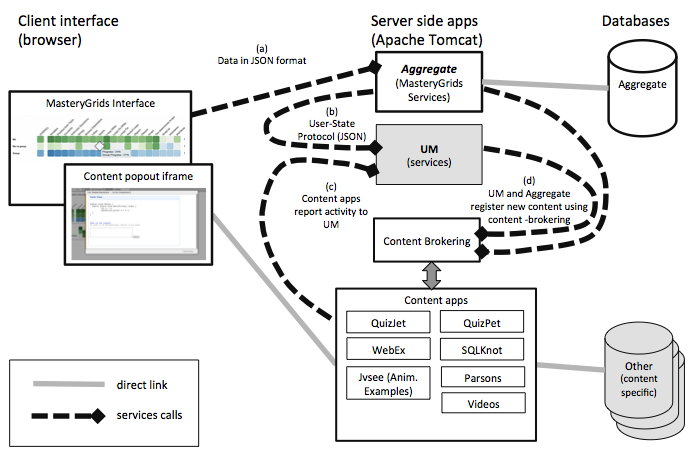Difference between revisions of "Aggregate"
From PAWS Lab
| Line 1: | Line 1: | ||
| − | We developed an adaptive social learning architecture Aggregate to support [[Mastery Grids Interface]]. This architecture supports several kinds of open student modeling, social comparison, and recommendation. The architecture fulfills a major objective, portability, which is the ability to be integrated to other systems with little set up and modification. The architecture is modular and includes different software components as follows: | + | We developed an adaptive social learning architecture Aggregate to support [[Mastery Grids Interface]]. We design this architecture to integrate content from diverse sources. The explanation of the procedures and links to associated resources are given below. |
| + | |||
| + | * [[Mastery Grids Interface]] receives all the information to display (this is course structure, links to content and progress levels of the learner and the group of learners) from services hosted in Aggregate (a in the diagram). This information is passed in JSON format. | ||
| + | |||
| + | * To let Mastery Grids know the level of progress of the learners in the topics and the content, Aggregates call services from a User Model (UM in the figure). See point b) in the figure. These services are documented in [https://github.com/PAWSLabUniversityOfPittsburgh/mastery-grids/blob/master/documentation/User_State_protocol.pdf User State Protocol] | ||
| + | |||
| + | This architecture supports several kinds of open student modeling, social comparison, and recommendation. The architecture fulfills a major objective, portability, which is the ability to be integrated to other systems with little set up and modification. The architecture is modular and includes different software components as follows: | ||
*frontend user-system interaction interface, the [[Mastery Grids Interface]] | *frontend user-system interaction interface, the [[Mastery Grids Interface]] | ||
Revision as of 18:03, 4 April 2016
We developed an adaptive social learning architecture Aggregate to support Mastery Grids Interface. We design this architecture to integrate content from diverse sources. The explanation of the procedures and links to associated resources are given below.
- Mastery Grids Interface receives all the information to display (this is course structure, links to content and progress levels of the learner and the group of learners) from services hosted in Aggregate (a in the diagram). This information is passed in JSON format.
- To let Mastery Grids know the level of progress of the learners in the topics and the content, Aggregates call services from a User Model (UM in the figure). See point b) in the figure. These services are documented in User State Protocol
This architecture supports several kinds of open student modeling, social comparison, and recommendation. The architecture fulfills a major objective, portability, which is the ability to be integrated to other systems with little set up and modification. The architecture is modular and includes different software components as follows:
- frontend user-system interaction interface, the Mastery Grids Interface
- backend Aggregate services communicating between the main interface and user modeling services ==> source code
- backend user modeling, personalization (recommendation, navigation support) services
- backend content providing applications
An overall architecture of the system can be sen in the following figure.

